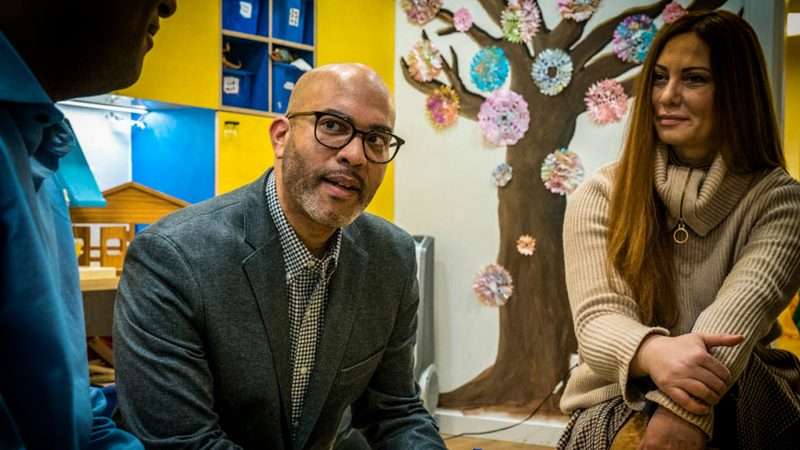Another day, another set of parents who discovered at the last minute that the planned reopening of their kids’ long-shuttered elementary schools was being thwarted by a politically powerful teachers union.
This time it was in the wealthy, New York City-adjacent suburb of Montclair, New Jersey, where Superintendent Jonathan Ponds announced late Friday “with deep regret” that the schools, closed for the past 319 days, wouldn’t even be reopening on a hybrid basis (half-in, half-remote), because negotiations with the Montclair Education Association (MEA) broke down. “I realize how unsettling this news is,” Ponds added.
The union seeks Plexiglass barriers, millions of dollars in ventilation upgrades, and for teachers to be vaccinated (New Jersey, unlike New York, does not as yet prioritize teachers for vaccines). MEA President Petal Robertson said in a statement, “It is our duty to ensure a safe and healthy workplace for our staff and a sound educational plan for our students.”
Remote learning has not been a sound “plan” for students. More like the opposite. But what about the main union contention, safety?
“The truth is, for kids K-12, one of the safest places they can be from our perspective is to remain in school,” then-director of the Centers for Disease Control Robert Redfield said in November.
COVID-19 infection rates at elementary schools in particular have been, compared to the country as a whole, microscopic—0.2 percent for teachers, 0.1 percent for students, according to economist Emily Oster’s database of 5,000-plus K-12 schools. The positive rate in New York City’s program of random school testing—currently standing at 0.52 percent from more than 360,000 tests since October—has consistently been around one-tenth of the overall community positivity rate.
And, observed Redfield, “The infections that we’ve identified in schools when they’ve been evaluated were not acquired in schools. They were actually acquired in the community and in the household….The data strongly supports that K-12 schools—as well as institutes of higher learning—really are not where we’re having our challenges.”
Unions may utilize the rhetoric of safety, but the determinative factor in school closures is their own power. As Reason Foundation Director of School Choice Corey DeAngelis has documented, the biggest correlating factor in all-remote learning is not the level of community infection, nor the quality of ventilation systems, but rather the comparative political strength of the relevant teachers union.
Union muscle is especially swole in Montclair. From The New York Times:
The newly elected mayor, Sean Spiller, is the No. 2 official at the statewide teachers’ union, the New Jersey Education Association. The president of the local teachers’ labor group, Petal Robertson, is competing for a leadership job at the association. And one of the governor’s top political strategists, Brendan Gill—an Essex County commissioner who is also the township’s Democratic chairman—lives there, as does the state’s new education commissioner, Angelica Allen-McMillan.
Mayor Spiller’s comment to the Montclair Local is a model of brow-furrowing concern, communicating empathy while accomplishing bupkis.
“Our educators, students, and parents…deserve high praise for going above and beyond to continue the work of teaching and learning,” Spiller wrote to the paper. “It is from that starting point that we need all parties working together….It is important that all educational stakeholders collaborate in order to ensure we have an appropriate and clearly articulated safe plan for any return to in-person instruction.”
Such impotent bureaucratic gobbledygook is hardly limited to union-hack Jersey mayors. Here’s the president of the United States on Monday, when asked, in light of the Chicago walkout, whether he believes teachers “should return to schools now”:
Biden’s stammering here is in direct proportion to the fundamental untenability of his—and teachers unions’—position. Headlines from Dec. 8 had it that the then-president elect was pledging to have K-12 schools reopen within his first 100 days in office, but too many people were expressing relief rather than looking at the caveats embedded (and italicized) in his headline-making quote: “It should be a national priority to get our kids back into school and keep them in school…If Congress provides the funding, we need to protect students, educators and staff. If states and cities put strong public health measures in place that we all follow, then my team will work to see that the majority of our schools can be open by the end of my first 100 days.”
So many terms with hedged or slippery definitions, so many union lawyers ready and incentivized to exploit.
Congress has provided scores of billions in COVID-related extra funding for K-12 schools—around $15 billion in the Coronavirus Aid, Relief, and Economic Security (CARES) Act last March, and $54 billion in the relief bill passed in December, on top of the Department of Education’s annual $40 billion or so. Biden’s latest $1.9 trillion coronavirus-relief proposal, billed as the first of two, includes another $130 billion earmarked directly for K-12 reopening, plus an additional $350 billion for states to patch their budgets, of which public education is always a large share.
Would even that be enough funding? Could unions (as in Montclair) still object to what they deem as insufficiently “strong public health measures”?
Well, consider this: The Biden administration is already signaling that the 100-day deadline (which comes April 30) won’t be met. “On a call with reporters Wednesday,” CNN reported last week, “Carole Johnson, Biden’s Covid testing coordinator, acknowledged that the reopening timeline may need to be extended.”
As New York Post columnist and fellow Brooklyn public school parent Karol Markowicz reiterated yesterday, “There is no amount of money the Biden administration can shower on schools to get them all open full-time in September. The [social distancing] ‘rules’ will ensure that many kids won’t be in class full-time for the foreseeable future. Unlike in cities across the world, the city and state will continue to ignore the fact that kids are at uniquely low risk from COVID-19.”
At the end of my latest print-magazine column, which was posted Monday but printed nearly three weeks before, I concluded, sourly, that “if New York City is indeed the model, the most ‘open’ thing will be the government’s checkbook—that and parents’ web browsers as they explore every option for their kids that doesn’t include a teachers union.”
Mayor Bill de Blasio, you may recall, announced with great fanfare in early December that, having arbitrarily closed all public schools three weeks prior, he was now set to reopen all five days a week! He even held up Gotham as a role model for the rest of the country, despite the fact that, to cite one of hundreds of thousands of examples, my 12-year-old has set foot on a campus all of seven times since March 15, 2020; zero since November.
Sure enough, just this afternoon on CNN, when asked about schools reopening not in 100 days but in September, City Council member and Health Committee Chair Mark Levine said: “It’s too soon.”
The same message is coming from the political class mismanaging affairs across the Hudson. Marie Blistan, president of the New Jersey Education Association (which is foursquare behind the unofficial teachers strike in Montclair), told the Times that the Garden State should be prepared for “interruptions in learning for maybe another year.”
Well, teachers unions should be prepared, too. Prepared for massive middle-class evacuations from public education in the blue states where unions hold sway.
Take a good, long look at this Burbio map of K-12 school reopenings across the country. “Just over one-third of US K-12 students [have] never been in the classroom this year and they are concentrated in two areas. We call them ‘Always Virtual”: West Coast and the Mid Atlantic states plus metro areas outside those states such as Chicago, Philadelphia, Kansas City, Cleveland, Boston, plus smaller cities,” the site notes. “These regions have a particular combination of state level regulations, logistical challenges and local stakeholder resistance that separate them from the rest of the country.”
Local stakeholder resistance. There are the taxpayers who fund K-12 education, and the 50 million-plus kids who enroll in K-12 public schools, yet the real-world power dynamics of the situation is that the holder of the stake is neither the funder nor consumer of this wretched monopoly product. It’s the public-sector unions, and the politicians they support.
Public school enrollment is down significantly this year. The U-Haul Index of domestic one-way moving-truck action shows Always Virtual states in the top six slots for losing trucks: California, Illinois, New Jersey, Massachusetts, Maryland, Oregon, while the three biggest gainers were the heavily reopened states of Tennessee, Texas, and Florida. The budgets both of state governments and local public schools are tied directly to the size of population. If people leave, so will their tax dollars, and the government jobs they fund.
The savvier among the Democratic political class realize this, which is why they’re busy in the post-Trump (meaning, post-scapegoat) era talking out of both sides of their mouth. American Federation of Teachers President Randi Weingarten, recently seen yukking it up in the White House with First Lady Jill Biden, has been saying since late November that “reopening schools is vital for the health and education of our children.” She co-wrote in USA Today this week that “with robust testing, we can open schools this spring before the vaccine is widely available.” Yet that happy conclusion, too, is conditioned on a lengthy and expensive wishlist.
There are signs that some unions are beginning to worry about the public catching onto the gap between macro reopening rhetoric and micro school closures. “Has the Public Turned on Teachers?” asked an Education Week headline Monday. “At First Deemed Pandemic Heroes, Some Now Feel Like Villains.” Well, refusing to teach in person after getting vaccinated may reduce the ol’ sympathy, yes. Or accusing parents who want schools to be reopened of “white supremacy.”
My beef, and the beefs of the public school parents I interact with, is not with our kids’ teachers, who have been doing their best, and clearly would like more reopening. The complaint is rather with teachers unions and union-backed politicians who, when not making an absolute mockery of science with their fearmongering, are operating as if the end goal is not to urgently and fully open every damn public school in the country, but rather to maximize the dollar squeeze from comparatively powerless taxpayers.
In the meantime, current or recent public school parents hearing rumor of September uncertainty will be busy checking local private school prices and further-flung real estate listings.
“We’ll have to see how many of those folks come back home after normalcy can be achieved,” David Adkins, executive director of the Council of State Governments, told the Times last month. If the exodus accelerates, Adkins warned, that could devolve into a “death spiral.”
No wonder preference for school choice is spreading. Parents want to be able to predict when their kids will attend school. It’s amazing that teachers unions do not yet seem to understand how much public sentiment is poised to turn against them.
Consider one final anecdote. Montclair, New Jersey, is a good liberal town filled with good liberal journalists who work in, or remotely from, good liberal Manhattan. And what was the headline about Monday’s botched reopening in the good liberal New York Times?
“Schools Were Set to Reopen. Then the Teachers’ Union Stepped In.“

from Latest – Reason.com https://ift.tt/3pqkKS4
via IFTTT


